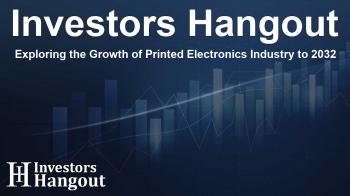Exploring the Growth of Printed Electronics Industry to 2032

Future Prospects of Printed Electronics Market
The global printed electronics market is rapidly evolving, with significant potential projected over the coming years. Industry forecasts suggest that the market will be valued at approximately US$ 62.57 billion by 2032, showcasing an impressive compound annual growth rate (CAGR) of 18.5% from 2025 to 2032.
Key Drivers of Market Growth
This market surge can be attributed to several key factors driving innovation and adoption. One of the leading influences is the increasing demand for lightweight electronic devices. In recent times, these devices have gained immense popularity, contributing to nearly half of market growth during the last year. Furthermore, printed electronics are notably more cost-effective compared to traditional electronic manufacturing methods, offering savings of about one-third over conventional competitors.
The Role of IoT in Printed Electronics
As the Internet of Things (IoT) technology continues to progress, its integration with printed electronics will significantly shape the future landscape of smart technology. Printed electronics leverage conductive inks and flexible substrates, paving the way for lightweight, economically viable components essential for IoT applications. These devices facilitate the integration of antennas, sensors, and circuits into everyday objects, enhancing both their functionality and connectivity.
Wearable and Flexible Device Demand
The demand for wearable technology is rapidly increasing, and this trend is favorable for the printed electronics market. The global wearables market is on track to hit a valuation of US$ 265 billion, with nearly half a billion devices expected to be sold annually. The growth is largely attributed to advancements in smartwatches and connected health devices.
Growth in Connected Devices
North America is witnessing significant adoption rates, with predictions indicating 439 million 5G connections by the end of the forthcoming years. In China, mobile subscriptions have already surpassed the half-billion mark, demonstrating the vast potential for connected devices in emerging markets. An intriguing trend is the increasing utilization of smart home products; recent surveys indicate that 32% of households now possess devices like smart locks and automated lighting, up from 24% just two years earlier.
Focus on Display Technology
The display segment leads the charge in the global printed electronics market, accounting for over 34.6% of revenue due to the rising demand for versatile, affordable display solutions in today's digitized world. Innovations in printed displays are driven by their ultra-thin, lightweight, and flexible characteristics, which cater to evolving consumer needs.
Advancements in Thin Film Transistors (TFTs)
Further development in this space includes the growing application of thin film transistors (TFTs), which have demonstrated significant versatility. Initially, TFTs played roles limited to sensors and logic circuits; however, their scope has expanded to critical applications, including radio frequency identification (RFID) tags. This evolution underscores the ongoing innovation within the printed electronics sector, particularly as the market for flexible displays continues to thrive.
Importance of Sustainability in Production
The integration of sustainable practices within the printed electronics industry is becoming increasingly crucial. Techniques such as inkjet printing now enable the production of TFTs under ambient conditions, significantly reducing production costs and minimizing environmental impact. As sustainability becomes a priority across industries, the potential for printed electronics to lead in eco-friendly manufacturing is promising.
Conclusion
In summary, the printed electronics market is poised for remarkable growth, propelled by advancements in technology and an increasing appetite for innovative applications. With billions of IoT devices expected to emerge in the following years, the synergy between IoT and printed electronics will play a significant role in defining the future of smart technology. Companies that embrace these trends will be well-positioned to leverage the opportunities presented by this dynamic and rapidly evolving industry.
Frequently Asked Questions
What is the projected value of the printed electronics market?
The printed electronics market is expected to reach approximately US$ 62.57 billion by 2032.
What factors are driving growth in this market?
The key drivers include the demand for lightweight devices, cost-effectiveness compared to traditional methods, and advancements in IoT technology.
How significant is the role of IoT in printed electronics?
IoT is crucial as it leverages printed electronics for seamless integration of smart components into various devices, enhancing functionality and connectivity.
What trends are emerging in wearable technology?
The wearables market is rapidly expanding, with forecasts indicating it will be worth US$ 265 billion, largely bolstered by smartwatches and health-related devices.
Why is sustainability important in printed electronics manufacturing?
Adopting sustainable practices is vital for minimizing environmental impact and aligning with global shifts towards eco-friendly solutions in production processes.
About The Author
Contact Riley Hayes privately here. Or send an email with ATTN: Riley Hayes as the subject to contact@investorshangout.com.
About Investors Hangout
Investors Hangout is a leading online stock forum for financial discussion and learning, offering a wide range of free tools and resources. It draws in traders of all levels, who exchange market knowledge, investigate trading tactics, and keep an eye on industry developments in real time. Featuring financial articles, stock message boards, quotes, charts, company profiles, and live news updates. Through cooperative learning and a wealth of informational resources, it helps users from novices creating their first portfolios to experts honing their techniques. Join Investors Hangout today: https://investorshangout.com/
The content of this article is based on factual, publicly available information and does not represent legal, financial, or investment advice. Investors Hangout does not offer financial advice, and the author is not a licensed financial advisor. Consult a qualified advisor before making any financial or investment decisions based on this article. This article should not be considered advice to purchase, sell, or hold any securities or other investments. If any of the material provided here is inaccurate, please contact us for corrections.

